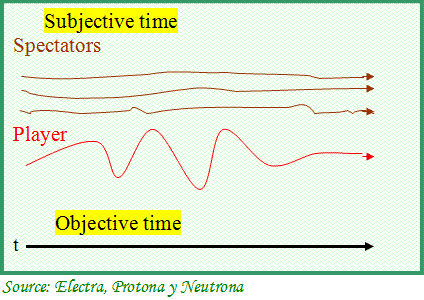2.c) Metaphysics, wrinkles of time and timeline
Here, the timeline corresponds to the subjective concept that we have seen in the beginning while discussing the theory of time. It is of a philosophical nature but trying to situate it within its real dimension and making a possible approximation with the language of mathematical formulas from the relations with love in the generic or universal sense.
Our brain needs a reference to work and not go crazy, so the personal timeline will always be for a hypothetical timeline, straight or corresponding with absolute, constant, or objective time.
Space, time, and love are the essential elements of life.
Time is the fourth dimension and of a different nature than the three spatial dimensions; it makes up the concept of life in the broad sense together with love for anyone of them. I am lost, and I do not know where it must mean that I am on the right track.
Speaking of poetic licenses, space and time could be abstract concepts or mental creations and, in turn, the mind as construction of love or the absolute reality.
Love is that desire or feeling of life while traveling together in space and time.
From the Equation of Love, it comes to that, when the distance in space is zero or time is infinite, Love is infinite. Seen in reverse, when Love is infinite, then life is eternal.
We believe love affects subjective time and makes wrinkles in the personal timeline. Better said, its speed or with even more precision, the changes in its speed or acceleration; this is not new in history since Albert Einstein had declared it to explain its concept of relativistic time.
The difference is that it seems that he said it as a metaphor, and we think of it as a reality; although this is metaphysics, We do not see the love variable in any of his equations! More than a metaphor, his theory seems an uncertain paradox.
Going back to the prose of science, we have all noticed the effect of love on the timeline wrinkles. Even children have seen it, or perhaps they feel it with higher intensity. In our opinion, they are no changes in the perception of absolute time but instead real variations or wrinkles in subjective time.
Let us look at some examples showing real and subjective variations of the speed of time:
Children
Children are somewhat accelerated or, in other words, their time goes much slower, and their timeline is more curve regarding adults. To a greater or lesser extent, we all feel that time passes us by more and more quickly, and, simultaneously, we are more at ease with it. As children, occasionally, time seems to last almost an eternity.
We are referring to something that we feel but that we do not manage to comprehend because it is one of the mysteries of life, although we are getting closer bit by bit.
Sports
At times, while playing tennis or a similar sport, it seems as if the player will not get to the ball; but, suddenly, it is as if time stopped, and miraculously the person manages to return the ball.
In this case, the spectators have also perceived something, they do not know very well what, but they ponder: “I thought for sure he wouldn’t get it on time.” Moreover, it is not about the fact that they do not know the player because they repeat the praise every occasion timeline curves to almost stopping a player’s time.This example is contrary to that mentioned previously; the physical activity does not create a reduced perception of time but the complete opposite. It is as if the focus of perception were on a different scale.
The explanation for the player’s situation should consist of using the change of his subjective time; he will obtain a critical perspective of each movement of the ball and his muscles. Therefore, the player optimizes activities incredibly for a normal process.
THE WRINKLES OF TIME 
Another element is that the change in speed in the subjective time or wrinkle in time implies the unconscious taking control of the movements. The player’s consciousness is, to put in some way, like an observer outside from himself with reduced power, given that a significant part of or the power operates directly under automatic mechanisms.
The spectators’ ruminations are due to the same reason of improbability because, for them, the process was regular, given that they have not experienced the variation of the subjective time of the player.
That is, objective time is the same for everybody, and it is an absolute concept by design.
The figure shows how absolute or objective time is the same for everyone at all times. On the contrary, the individual scale is different, as shown by the wrinkles of the timelines. It is as if the subjective time had folds throughout the absolute time.
What we want to say is that it is not possible to stretch or make the player’s timeline straight and thereby placing him in the future of the hit.
A glass falls on the floor
When a glass suddenly moves and begins to fall to the floor, it changes our concentration, our perception of the outside world. It seems there is only one object moving in the air; we can observe how it moves as if it were a slow-motion movie. It is a beautiful thing! With luck, we can manage to stand up and avoid it breaking. Similarly, not like in the other example, we can call it to glass loved!
We could say that our life rhythm altered, perception by a unit of time accelerated, the time stopped, and the timeline is almost vertical; although it is not always identical, they are similar ways of saying the same thing.
Another way of explaining what happens within General Physics is to imagine we are driving a car at 100 km per hour. If we want to focus more on the houses or the trees on the side of the road, we can do it by going slower. That is, reducing the speed –space by a unit of time–, or increasing the rate of time –time by the unit of space–, given that the last concept is the inverse of standard speed.
